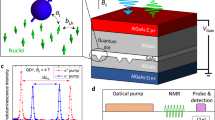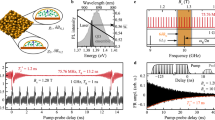Abstract
One of the key challenges in spectroscopy is the inhomogeneous broadening that masks the homogeneous spectral lineshape and the underlying coherent dynamics. Techniques such as four-wave mixing and spectral hole-burning are used in optical spectroscopy1,2,3, and spin-echo4 in nuclear magnetic resonance (NMR). However, the high-power pulses used in spin-echo and other sequences4,5,6,7,8 often create spurious dynamics7,8 obscuring the subtle spin correlations important for quantum technologies5,6,9,10,11,12,13,14,15,16,17. Here we develop NMR techniques to probe the correlation times of the fluctuations in a nuclear spin bath of individual quantum dots, using frequency-comb excitation, allowing for the homogeneous NMR lineshapes to be measured without high-power pulses. We find nuclear spin correlation times exceeding one second in self-assembled InGaAs quantum dots—four orders of magnitude longer than in strain-free III–V semiconductors. This observed freezing of the nuclear spin fluctuations suggests ways of designing quantum dot spin qubits with a well-understood, highly stable nuclear spin bath.
This is a preview of subscription content, access via your institution
Access options
Subscribe to this journal
Receive 12 print issues and online access
$259.00 per year
only $21.58 per issue
Buy this article
- Purchase on SpringerLink
- Instant access to full article PDF
Prices may be subject to local taxes which are calculated during checkout




Similar content being viewed by others
References
Borri, P. et al. Ultralong dephasing time in InGaAs quantum dots. Phys. Rev. Lett. 87, 157401 (2001).
Volker, S. Hole-burning spectroscopy. Annu. Rev. Phys. Chem. 40, 499–530 (1989).
Yang, L. et al. Two-colour spin noise spectroscopy and fluctuation correlations reveal homogeneous linewidths within quantum-dot ensembles. Nature Commun. 5, 5949 (2014).
Hahn, E. L. Spin echoes. Phys. Rev. 80, 580–594 (1950).
Biercuk, M. J. et al. Optimized dynamical decoupling in a model quantum memory. Nature 458, 996–1000 (2009).
Bar-Gill, N. et al. Suppression of spin-bath dynamics for improved coherence of multi-spin-qubit systems. Nature Commun. 3, 858 (2012).
Tyryshkin, A. M. et al. Electron spin coherence exceeding seconds in high-purity silicon. Nature Mater. 11, 143–147 (2012).
Li, D., Dementyev, A. E., Dong, Y., Ramos, R. G. & Barrett, S. E. Generating unexpected spin echoes in dipolar solids with π pulses. Phys. Rev. Lett. 98, 190401 (2007).
Merkulov, I. A., Efros, A. L. & Rosen, M. Electron spin relaxation by nuclei in semiconductor quantum dots. Phys. Rev. B 65, 205309 (2002).
de Sousa, R. & Das Sarma, S. Theory of nuclear-induced spectral diffusion: spin decoherence of phosphorus donors in Si and GaAs quantum dots. Phys. Rev. B 68, 115322 (2003).
Yao, W., Liu, R.-B. & Sham, L. J. Theory of electron spin decoherence by interacting nuclear spins in a quantum dot. Phys. Rev. B 74, 195301 (2006).
Bluhm, H. et al. Dephasing time of GaAs electron-spin qubits coupled to a nuclear bath exceeding 200 μs. Nature Phys. 7, 109–113 (2011).
Press, D. et al. Ultrafast optical spin echo in a single quantum dot. Nature Photon. 4, 367–370 (2010).
De Greve, K. et al. Ultrafast coherent control and suppressed nuclear feedback of a single quantum dot hole qubit. Nature Phys. 7, 872–878 (2011).
Greilich, A., Carter, S. G., Kim, D., Bracker, A. S. & Gammon, D. Optical control of one and two hole spins in interacting quantum dots. Nature Photon. 5, 702–708 (2011).
Hansom, J. et al. Environment-assisted quantum control of a solid-state spin via coherent dark states. Nature Phys. 10, 1745–2473 (2014).
Urbaszek, B. et al. Nuclear spin physics in quantum dots: an optical investigation. Rev. Mod. Phys. 85, 79–133 (2013).
Cai, J., Retzker, A., Jelezko, F. & Plenio, M. B. A large-scale quantum simulator on a diamond surface at room temperature. Nature Phys. 9, 168–173 (2013).
de Sousa, R. & Das Sarma, S. Electron spin coherence in semiconductors: considerations for a spin-based solid-state quantum computer architecture. Phys. Rev. B 67, 033301 (2003).
Chekhovich, E. A., Hopkinson, M., Skolnick, M. S. & Tartakovskii, A. I. Suppression of nuclear spin bath fluctuations in self-assembled quantum dots induced by inhomogeneous strain. Nature Commun. 6, 6348 (2015).
Chekhovich, E. A. et al. Structural analysis of strained quantum dots using nuclear magnetic resonance. Nature Nanotech. 7, 646–650 (2012).
Munsch, M. et al. Manipulation of the nuclear spin ensemble in a quantum dot with chirped magnetic resonance pulses. Nature Nanotech. 9, 671–675 (2014).
Udem, T., Holzwarth, R. & Hansch, T. W. Optical frequency metrology. Nature 416, 233–237 (2002).
Dzhioev, R. I. & Korenev, V. L. Stabilization of the electron-nuclear spin orientation in quantum dots by the nuclear quadrupole interaction. Phys. Rev. Lett. 99, 037401 (2007).
Latta, C., Srivastava, A. & Imamoglu, A. Hyperfine interaction-dominated dynamics of nuclear spins in self-assembled InGaAs quantum dots. Phys. Rev. Lett. 107, 167401 (2011).
Madhu, P. & Kumar, A. Direct cartesian-space solutions of generalized Bloch equations in the rotating frame. J. Magn. Reson. Ser. A 114, 201–211 (1995).
Van Vleck, J. H. The dipolar broadening of magnetic resonance lines in crystals. Phys. Rev. 74, 1168–1183 (1948).
Khaetskii, A. V., Loss, D. & Glazman, L. Electron spin decoherence in quantum dots due to interaction with nuclei. Phys. Rev. Lett. 88, 186802 (2002).
Bechtold, A. et al. Three-stage decoherence dynamics of an electron spin qubit in an optically active quantum dot. Nature Phys 11, 1005–1008 (2015).
Acknowledgements
The authors are grateful to K. V. Kavokin for useful discussions. This work has been supported by the EPSRC Programme Grant EP/J007544/1, ITN S3NANO. E.A.C. was supported by a University of Sheffield Vice-Chancellor’s Fellowship and a Royal Society University Research Fellowship. I.F. and D.A.R. were supported by EPSRC. Computational resources were provided in part by the University of Sheffield HPC cluster ‘Iceberg’.
Author information
Authors and Affiliations
Contributions
M.H., I.F., D.A.R., J.N., R.M.S., A.J.B. and A.J.S. developed and grew the samples. A.M.W. and E.A.C. conceived and designed the experiments and analysed the data. A.M.W. performed the experiments. E.A.C. performed the numerical modelling. E.A.C., A.M.W., M.S.S., A.I.T., G.B. and A.J.B. wrote the manuscript with input from all authors. E.A.C. coordinated the project.
Corresponding authors
Ethics declarations
Competing interests
The authors declare no competing financial interests.
Supplementary information
Supplementary information
Supplementary information (PDF 10477 kb)
Rights and permissions
About this article
Cite this article
Waeber, A., Hopkinson, M., Farrer, I. et al. Few-second-long correlation times in a quantum dot nuclear spin bath probed by frequency-comb nuclear magnetic resonance spectroscopy. Nature Phys 12, 688–693 (2016). https://doi.org/10.1038/nphys3686
Received:
Accepted:
Published:
Issue date:
DOI: https://doi.org/10.1038/nphys3686
This article is cited by
-
Pulse control protocols for preserving coherence in dipolar-coupled nuclear spin baths
Nature Communications (2019)
-
Nuclear spins get a comb-over
Nature Physics (2016)
-
Quantum dot spin coherence governed by a strained nuclear environment
Nature Communications (2016)



